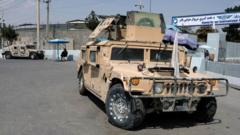Reports indicate that during the Taliban's advance, many Afghan soldiers abandoned their posts, leaving equipment behind, and some US forces also left gear as they withdrew. Notably, a closed-door UN Security Council session revealed that the Taliban has admitted to losing track of approximately half of their acquired arsenal, validating earlier concerns raised by various sources.
A February UN report underscored the troubling reality that affiliates of al-Qaeda, such as Tehreek-e-Taliban Pakistan and the East Turkestan Islamic Movement, are accessing Taliban-captured weapons through purchases on the black market, a thriving trade noted by observers on the ground.
In response to queries from the BBC, Taliban officials have insisted on the security and proper storage of the seized weaponry, flatly denying claims of smuggling. Nevertheless, UN reports have suggested a black market flourishing under local Taliban commanders, who are allowed to keep a percentage of the seized arms and frequently trade them to consolidate their power or to finance operations.
A former journalist in Kandahar indicated that an open arms market previously existed and has now shifted online via messaging apps. The marketplace allows local commanders and wealthy individuals to buy and sell various US military weapons, predominantly leftovers from prior Afghan engagements with US forces.
While US oversight bodies, such as the Special Inspector General for Afghanistan Reconstruction (SIGAR), have acknowledged inaccuracies in tracking military equipment, the Trump administration previously expressed interest in retrieving the arms left behind. During a cabinet meeting, Trump cited an astronomical $85 billion as being left in weaponry, a figure that has stirred controversy and conflicting opinions regarding its calculation and veracity.
Despite the Taliban's acknowledgment of capturing and utilizing these sealed weapons to defend against threats, military analysts note considerable limitations in their operational capacity regarding advanced machinery like Black Hawk helicopters. While they have effectively utilized more rudimentary equipment in operational settings, significant concerns linger over the potential for these weapons to further empower militant factions in the region, raising alarms about stability in Afghanistan and beyond.
As calls for accountability and action continue, uncertainty looms about the future of US military assets in Afghanistan and their role in fostering regimes of violence against local and regional adversaries.
A February UN report underscored the troubling reality that affiliates of al-Qaeda, such as Tehreek-e-Taliban Pakistan and the East Turkestan Islamic Movement, are accessing Taliban-captured weapons through purchases on the black market, a thriving trade noted by observers on the ground.
In response to queries from the BBC, Taliban officials have insisted on the security and proper storage of the seized weaponry, flatly denying claims of smuggling. Nevertheless, UN reports have suggested a black market flourishing under local Taliban commanders, who are allowed to keep a percentage of the seized arms and frequently trade them to consolidate their power or to finance operations.
A former journalist in Kandahar indicated that an open arms market previously existed and has now shifted online via messaging apps. The marketplace allows local commanders and wealthy individuals to buy and sell various US military weapons, predominantly leftovers from prior Afghan engagements with US forces.
While US oversight bodies, such as the Special Inspector General for Afghanistan Reconstruction (SIGAR), have acknowledged inaccuracies in tracking military equipment, the Trump administration previously expressed interest in retrieving the arms left behind. During a cabinet meeting, Trump cited an astronomical $85 billion as being left in weaponry, a figure that has stirred controversy and conflicting opinions regarding its calculation and veracity.
Despite the Taliban's acknowledgment of capturing and utilizing these sealed weapons to defend against threats, military analysts note considerable limitations in their operational capacity regarding advanced machinery like Black Hawk helicopters. While they have effectively utilized more rudimentary equipment in operational settings, significant concerns linger over the potential for these weapons to further empower militant factions in the region, raising alarms about stability in Afghanistan and beyond.
As calls for accountability and action continue, uncertainty looms about the future of US military assets in Afghanistan and their role in fostering regimes of violence against local and regional adversaries.



















